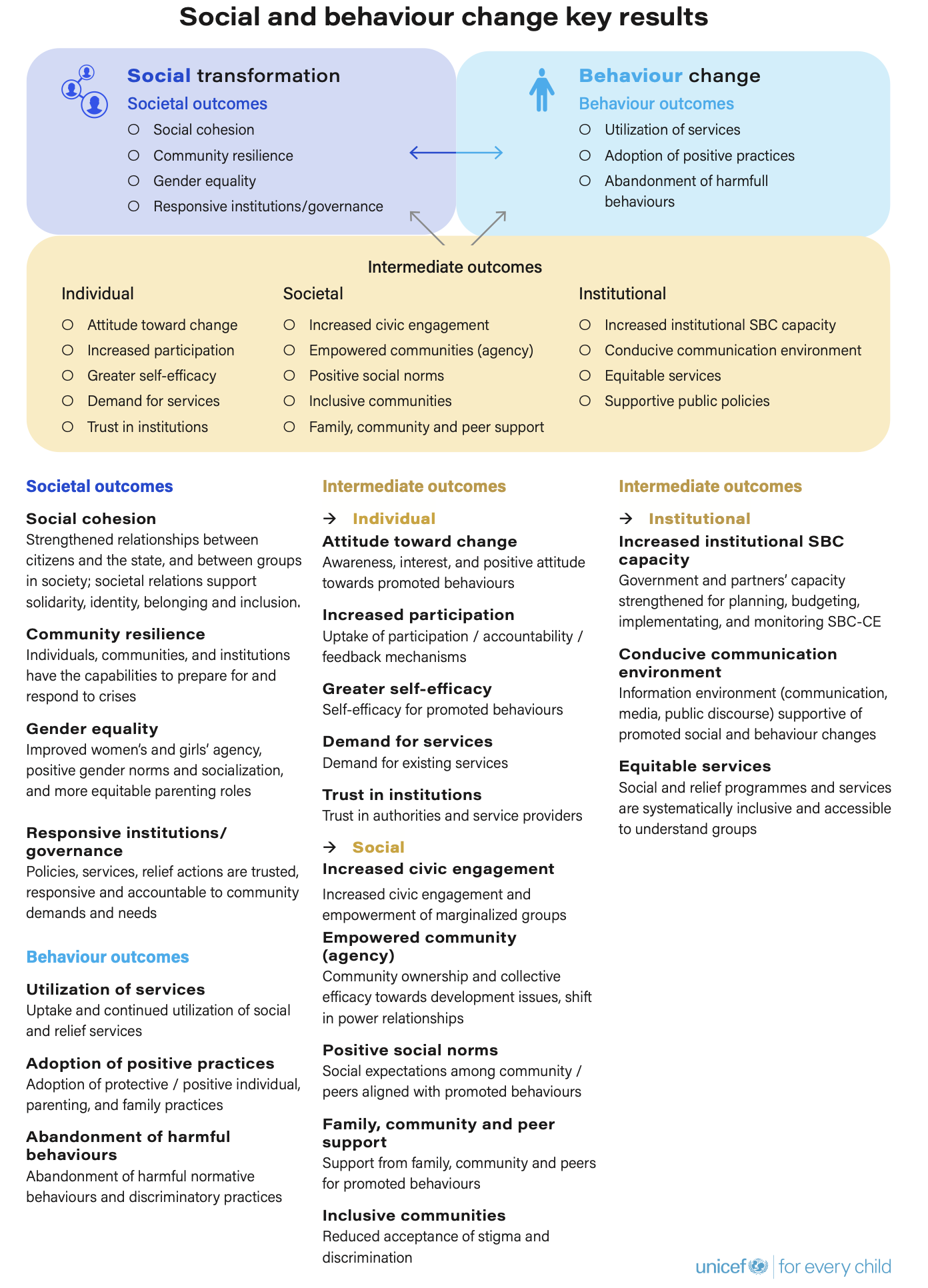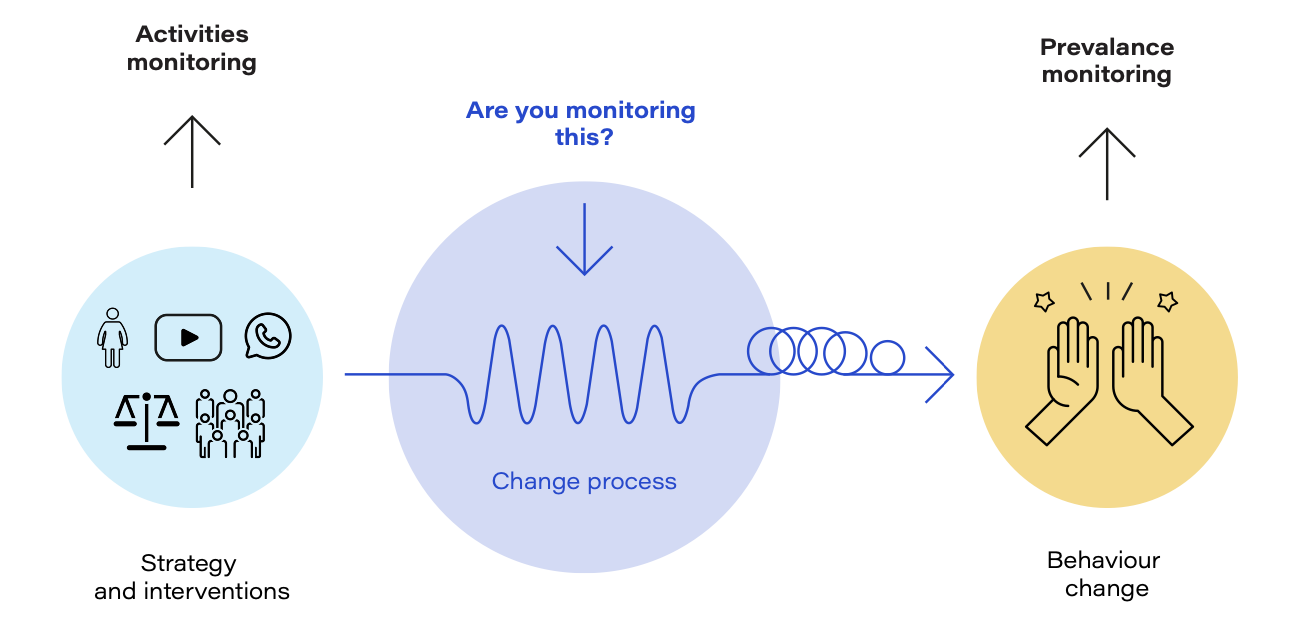
Key Results
Social and behaviour change outcomes
Introduction
Social and Behaviour Change results are a universe of positive transformations: a hesitant mother decides to vaccinate her child; a father tries new ways of teaching his children; an adolescent works to improve her mental well-being; a community becomes less accepting of child marriage; local organizations mobilize for women’s rights to be recognized; a society embraces children with disabilities through systems that include and prioritize their needs; a sector where decision-makers partner with the people they serve. All of these changes are the results of SBC, and contribute to achieving Child and Human Rights and Development Goals.
As mentioned in the Vision for SBC, a lot of what UNICEF does is the promotion of healthy, preventive and protective behaviours for children. But behavioural and social results are inextricably linked. Sustained behaviour change often requires social change, as these practices frequently depend on their social acceptability, which depends on the dynamics, norms, stigmas and power relationships within a community. And more broadly, fulfilling the rights of children and their families' rests upon large-scale, positive transformation of communities and societies, beyond sectoral siloes, to promote change such as gender equality, community resilience, social cohesion and responsive governance. This obviously applies to all stakeholders and efforts, beyond UNICEF.

These generic results are the most common and important, in terms of both social change and behaviour change, across all goal areas.
A lower level of results or ‘’outputs’’, not displayed on the diagram, will contribute to the achievement of the intermediate outcomes. Awareness, knowledge and beliefs are examples of behavioural outputs which feed into and contribute to define someone’s attitude (intermediate outcomes). Examples of these lower level results are provided later in the guidance (see Selecting Results).
To illustrate how these conceptual outcomes might look in practice, below are a few hypothetical results we hope to achieve when encouraging exclusive breastfeeding.
Behavioural outcomes
- Children are exclusively breastfed during the first six months of their lives (adoption of positive practice)
- Parents regularly attend the infant nutrition counselling sessions (utilization of services)
Intermediate outcomes
Individual
- Parents think that breast milk is the best food for their newborns (attitude)
- Mothers have both the skills and confidence to exclusively breastfeed their babies for six months (self-efficacy)
- Parents perceive the value of nutrition counselling sessions (demand for services)
- Parents trust the doctors and nurses at their local health centre (trust)
Societal
- Local women associations, mothers groups and religious leaders are engaged in promoting exclusive breastfeeding (empowered communities)
- Parents believe that most women in their communities practise exclusive breastfeeding (positive norms)
- Men approve of mothers breastfeeding in public/collective settings when the breast and baby are covered (positive norms)
- Grandmothers are supportive of their daughters/daughters-in-law practicing exclusive breastfeeding (family support)
Institutional
- Nurses and doctors are trained in active listening and equipped to provide breastfeeding advice (institutional SBC capacity)
- Nutrition outreach sessions are organized and available for free in poor communities (equitable services)
- Marketing for breast milk substitutes is banned in the country (supporting public policies)
- Break time for breastfeeding mothers and dedicated breastfeeding spaces are included in national labour laws (supporting public policies)
- Women who breastfeed are positively depicted in movies and soap operas (conducive communication environment)
The field of SBC programming has long suffered from a monitoring and evaluation ‘black box,’ with SBC results only tracked and assessed against activities on one end and outcomes on the other end. In other words, data is often collected on processes and activities – such as conducting media campaigns, distributing information materials and engaging communities, recording results that may only include number of people reached, the number of social workers trained -, or on the shift in prevalence/incidence of the target behaviours. But the right place for decision-makers, practitioners and communities to focus their attention is often exactly in between, analysing and measuring how the underlying drivers of behaviours evolve and how the barriers to change are lifted, as milestones on the way to changing the prevalence or incidence of a behaviour.
For many reasons, stemming from both the Behavioural Science perspective (how practices come to exist and be sustained) and the work processes in our industry (funding and programming cycles, and results that can be achieved in such timeframes), our monitoring attention needs to shift to determinants such as self-efficacy, social expectations, trust in institutions and access to services, as well as many other intermediate results.

To explore a larger set of possible behavioural results, take a look at The Behavioural Drivers Model.
For more information on how to incorporate SBC results into your Theory of Change see Selecting SBC results.

Vision - Key Results
Download this article as a PDF
You can download the entire page as a PDF here





